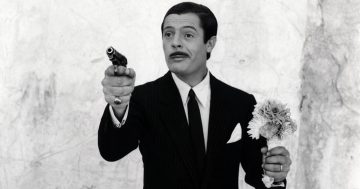Film Noir
Film Art
We could make this publication thanks to small donations. How is 3 minutos de arte supported?
Film Noir (French: Dark Film)
It is a genre that reached its peak in the forties and fifties in the United States. The Maltese Falcon (John Huston, 1941) was the film that is considered to be the starter of the genre. And although it can be said it is mainly American, the name “film noir” in French, is usually used, an influence of European film criticism.
Film noir is a cinema with a dense, dark atmosphere. It is a type of cinema where the plot usually revolves around crime, corruption, betrayal, and the dark side of the human soul.
The boundary between the hero and the villain is blurred. And the hero, even if he is a hero, usually has a dark past and unethical methods.
The chiaroscuro, the strong clash of light and shadows, is a device used to make that atmosphere denser, to highlight the threatening violence and the murky psychology of the characters. Definitely, an inheritance of German expressionist cinema, where desperate climates are generated at times, and where the moods of the characters are visually expressed.
In many of these films, the protagonist is a detective with a chaotic life and dubious morals. And a woman —usually a femme fatale— asks them for help, which adds the sensual ingredient and erotic tension to the plot. The famous detectives Sam Spade and Phillip Marlowe —created by novelists Dashiel Hammet and Raymond Chandler, respectively— are an example, and Humphrey Bogart played both roles in different films.
The film noir shows a violent, corrupt, vicious, and not very optimistic society. For this very reason, its protagonists, tough, insensitive, and hopeless, do not usually “fix it.” There are usually no happy, perfect endings. Chaos and darkness continue.
And it is remarkable how, in the case of the detectives, we have a diametrically opposed difference between the American and the British ones. The latter solve their cases with “elegance,” restoring order; on the other hand, the Americans, whether they solve their cases or not, fail to improve the chaotic society in which they live.
Image: Humphrey Bogart and Lauren Bacall in The Big Sleep (Howard Hawks, 1946).
Representative films:
The Maltese Falcon (John Huston, 1941)
Double Indemnity (Billy Wilder, 1944)
Laura (Otto Preminger, 1944)
The Woman in the Window (Fritz Lang, 1944)
Scarlet Street (Fritz Lang, 1945)
The Big Sleep (Howard Hawks, 1946)
The Killers (Robert Siodmak, 1946)
The Lady from Shanghai (Orson Welles, 1947)
Out of the Past (Jacques Tourneur, 1947)
The Asphalt Jungle (John Huston, 1950)
Angel Face (Otto Preminger, 1952)
The Big Heat (Fritz Lang, 1953)
Human Desire (Fritz Lang, 1954)
Touch of Evil (Orson Welles, 1958)
Recommended links:
You can also find more material using the search engine.




0 Comments